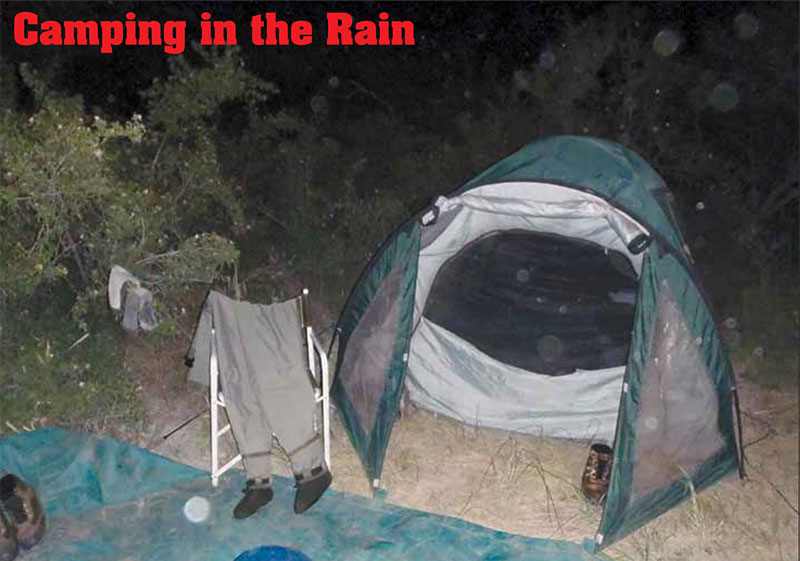
This year I am going to give you some tips on camping. I hope they come in handy.
Choose the right sleeping bag for wet conditions. Down is worthless when wet, and can be very difficult to dry out. A good synthetic bag will keep you warm when wet and dry out quickly. To rid the sleeping bag of the clammy feeling when you crawl in, insert a homemade liner. Fold a regular cotton or flannel bedsheet in half, sew the bottom, and halfway up the side. Insert liner, sewn side to zipper. The additional weight is minimal; it adds extra warmth and also can easily be removed for cleaning.
Tarps
Pitch the tarps first thing. The key to a successful rainy camp is to have tarp shelters. Having great tents is one thing, but nobody wants to sit in one all day to stay dry. Pitch a main tarp over the picnic table (if available) for a dining/ games area, and another as a place to sit and read. A multitude of smaller tarp shelters around camp can allow the kids to have their own, and the adults to be able to sit around and talk.
Rain Gear
Choices include a poncho or rain jacket and pants. Purchase good quality as it pays off in the long run. Wear a poncho while hiking in the rain because it releases water vapour generated from sweating. A rain suit is better if you are canoeing or sitting in a boat.
Outer Dress
No cotton. Once it gets wet, it stays cold and clammy. Instead, layer lightweight nylon clothing and synthetic underwear in the warmer months and switch to wool and polypropylene layers in the winter. My standard clothing for any time of year starts with a set of polypropylene underwear. It wicks away moisture and is a great start toward staying comfortable.
Bring a Lot of Plastic Bags
The wonderful thing about plastic bags of all sizes—trash bags, sealing sandwich bags and so forth—is that they keep water out just as effectively as high-end dry bags. They take up virtually no room in your pack and cost next to nothing. You can’t reuse them like you can brand name camping dry bags, but for a single trip, plastic bags are a saving grace if you end up camping in the rain.
Always carry a trash bag to cover your hiking pack at night, and one to store dry firewood. Sealable plastic bags will protect smaller items like digital camera memory cards, matches and important papers like fishing licenses, money and passport. Use plastic bags: I always pack gear and clothing in various sizes of plastic bags. Large trash bags and heavy ziplocks allow you to cover just about anything. The 2½ gallon ziplocks are particularly useful. My back pack is water resistant, and has a cover, so just about everything has two layers of waterproofing.
Newspapers
Take along a little newspaper and keep it dry. This can be highly beneficial for several reasons if it rains. In addition to possibly providing some reading if you have to pass the rainy time hunkered down in a tent, it also serves as a useful fire starter if the rest of the forest is waterlogged. Also, stick a few rolled-up clumps of newspaper into your shoes at night. This will speed up the drying process by sucking moisture out of the shoe leather like a sponge.
Water Collection
Seize the opportunity to collect some of it for drinking water, put your open water bottle out to catch the drops, or set up a stretched tarp to funnel water into your bottle or cooking pot.
You want to collect water directly as it falls; don’t use any water that has slid down a tree, dripped from branches or touched rocks. It’s never a bad idea to filter your water before you drink it, even rain water.
Enjoy Your Experience
If you’ve prepared for wet weather, you won’t be uncomfortable. If you are hiking or canoeing, stop and haul out the rain gear when the signs point to precipitation—don’t wait for the water to fall. Stay prepared for rain, and it doesn’t become an emergency. Even if it’s the coldest, wettest, most challenging outing, you will remember it most fondly.
Visit the Store
$34.99
$34.99
Featured Catch

Joel Unickow halibut (Photo: Rob Frawley Lucky Strike Sportfishing Tofino)







